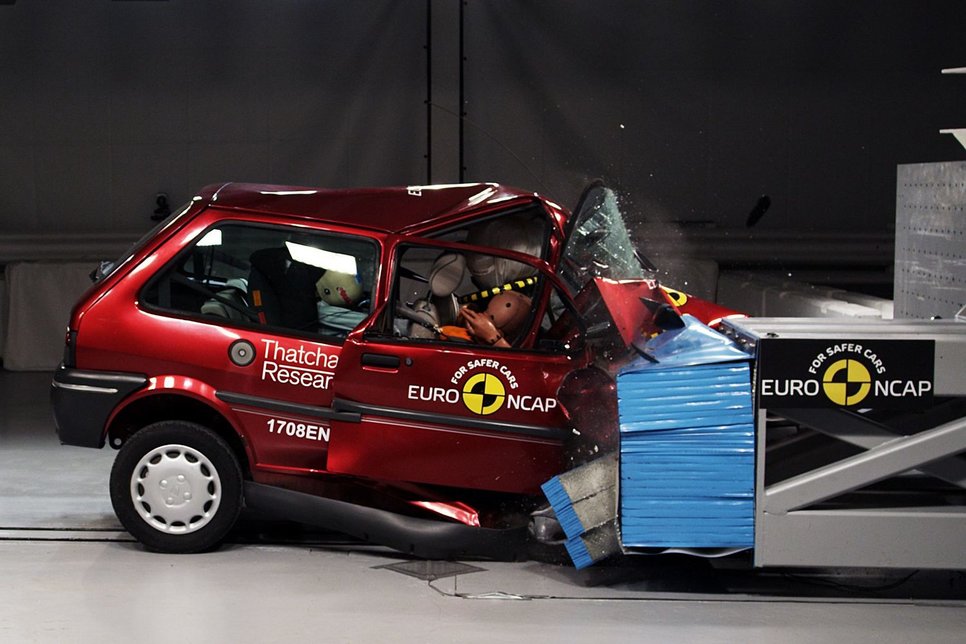
Euro NCAP crash tests: asterisk not equal to asterisk
If you are looking for a car for yourself, and one of the most important criteria for choosing a particular model is safety, then you can hardly do without a detailed analysis of the Euro NCAP safety tests. However, it should be borne in mind that the criteria for judging crashed cars have changed significantly in recent years and, for example, a three-star result in 2015 does not necessarily mean a car is less safe than a four-star model obtained in 2013.
Although the Euro NCAP organization was established in 1996, and the first crash test results were published a year later, work on creating a single crash test standard has been going on since the 70s. In Europe, they were chaired by the European Committee for Experimental Vehicles, but the first procedures to test new vehicles for the safety they provide (the New Car Assessment Program - NCAP) were established in 1979 by the National Highway Traffic Administration. Security Administration - NHTSA). These procedures then served as the basis for the creation of similar standards for European new car crash tests.
1996/1997 - humble beginnings
The first round of Euro NCAP crash tests in 1996 covered seven models from the so-called supermini segment (Ford Fiesta, Nissan Micra, Opel Corsa, Volkswagen Polo, Renault Clio, Rover 100 and Fiat Punto). Initially, these results were sent to specialists and concerns, and only in February 1997 were they published and presented to the general public.
In the early years, models were evaluated according to two criteria - the protection of adult passengers (a frontal and side impact test was carried out) and the protection of pedestrians. In both of these parts, the car could receive a maximum of four stars in each part evaluated, and in the second round of testing, the Volvo S40 received the highest four-star rating for adult occupant protection. However, Euro NCAP has been strongly criticized by many manufacturers for the fact that the evaluation criteria introduced are too strict and that many models do not stand a chance of obtaining four or even three star results.
1999 - five stars
Despite these allegations, just two years later, Euro NCAP authorities decided to upgrade the rating to five stars for adult occupant protection (pedestrian protection was still a maximum of four stars). And although it seemed that the first five-star model would have to wait a long time, already in 2001 Renault Laguna achieved such a result. And when Renault Clio achieved a similar result in 2005, it became clear that even the smallest models could offer the highest level of safety.
2000 crash test with support
Before this happened, Euro NCAP expanded its crash testing with another test, the pole crash test. Before that, only two tests had been carried out - a frontal impact and a side impact. In the first case, the car runs into a deformable obstacle at a speed of 64 km/h and 40%. shifting (40% of the width of the front of the body encounters an obstacle). Such parameters should reflect the most typical traffic accidents. In turn, the side impact test involves hitting the side of the car (in the area of the B-pillar) with a deformable platform at a speed of 50 km/h.
The pole crash test, introduced in 2000, is designed to simulate a traffic accident where a car hits a tree or other pole with the side of the car. In this case, the test vehicle moves along the platform at a speed of 32 km/h and runs into a narrow metal pole.
The pedestrian impact test is carried out at a speed of 40 km/h. The types of possible injuries of the lower extremities after hitting the bumper, the upper limbs after hitting the front edge of the hood and the head after hitting the hood or windshield are measured.
2003 - child protection test
Although the crashed cars already had seats with mannequins imitating small children, it is only since 2003 that the protection provided by this car to the smallest passengers has been separately evaluated.
The car places two mannequins - simulating an 18-month-old and a 3-year-old child - in the rear seats in car seats recommended by the manufacturer. These dummies take part in both frontal and side impact tests. However, the assessment takes into account not only the results of the readings of the sensors placed on the dummies, but also the convenience of attaching the seats in the car, the presence of the ISOFIX system and the possibility of detaching the front passenger. air bag.
As with adult occupant protection, a maximum of five stars could be awarded for child protection.
2008 - Rear impact test
In November 2008, Euro NCAP published for the first time results on the protection of the spine (primarily the cervical spine) that car seats should provide. Whiplash injuries are typical injuries that occur when another vehicle collides with the rear of the vehicle. The first published results of this test (25 models) have not yet affected the final rating, but from next year this type of test is one of the elements that influence the number of stars received.
2009 - one overall assessment
Since 2009, however, more than just whiplash protection has joined the Euro NCAP crash test procedure. This year there has been a real revolution in the assessment system. Since the authorities of this organization recognized that manufacturers are focusing on testing the protection of adult passengers, they decided to force car companies to pay more attention to other categories of crash tests.
Since 2009, a single cumulative star rating has been introduced for the model, replacing the three separate ratings received so far. Thus, receiving five stars depended on the corresponding (point) assessment in all considered categories. Thus, there was no chance that a model that scored poorly in at least one category would receive the maximum number of stars.
An additional obstacle was the introduction since 2009 of another category - the presence of electronic security systems. However, until 2012, there were only three such systems - ESP, speed assistant and a reminder of seat belts.
2010 - Advanced Euro NCAP
The rapid development of modern technologies, mainly related to increasing the level of security, led to the fact that Euro NCAP decided to highlight those brands that implement such solutions in their models. The Euro NCAP Advanced award does not affect the overall rating of the model, but shows potential buyers which technologies are especially useful and which models are equipped with them.
2013/2014 - testing of AEB systems (Autonomous Emergency Braking)
In 2013, Euro NCAP took a close look at autonomous braking systems that were starting to appear on newer models. A year later, they became another element of security systems for which points were awarded. Both systems were evaluated, operating at low and high speeds. Additional points can also be earned for Euro NCAP-compliant pre-collision warning systems that keep the vehicle in the lane and warn of unintentional lane changes.
2015 - full width frontal collision
Since 2015, the second frontal impact test has become an important element influencing the assessment of adult occupant safety. In this test, the vehicle hits a rigid, non-deformable obstacle across its entire front width.
2016 - "Older Kids" and double rating
This year has brought another fairly significant change in the evaluation of the tested cars. In terms of child protection, dummies imitating children aged 6 and 10 replaced the existing ones. The main difference from previous tests is that the "older children" are already wearing standard seat belts.
Since 2016, an autonomous braking system that reacts to pedestrians has appeared among the evaluated safety systems.
A very important innovation, which can significantly affect the ratings awarded to individual models, is the so-called Dual Rating. Its basic assumption is the security check provided by the underlying hardware versions of the individual models. Therefore, only those safety features that are offered in all EU markets in all equipment variants of the tested models are taken into account. This will necessarily affect the differentiation of the final results depending on the price range to which this model belongs. In the case of budget models, where price plays a very important role, the basic options are rarely richly equipped. Unlike many models, for example from the premium segment, where we already have long equipment lists in the “base”.
In order not to disadvantage cheaper brands, and often without a solution (either accepting a worse test result, or the need to increase equipment, and therefore increase prices for basic versions), Euro NCAP introduced the possibility of an additional test. The version equipped with the so-called security package, ie. with those elements available in all European markets as an option. Through this double assessment, the potential customer can see how the level of safety changes as the equipment improves.
This is not the end of change
Although, as you can see, in recent years (especially after 2009) Euro NCAP makes some significant changes almost every year, the improvements are not over yet. The Roadmap 2015, adopted in 2020, already shows what changes await us in this decade. Once completed, we will have modified frontal and side impact tests, in 2018 there will be new criteria for seat belts, in the next few years, more and more requirements will be placed on AEB systems, which should detect not only pedestrians, but also cyclists, as well as work well not only in good weather, but also in conditions of poor visibility.
When considering the results of crash tests in terms of choosing the safest models, you should keep in mind the changes mentioned above. Every year, with successive changes in testing procedures and evaluation criteria, not only does it become more and more difficult to achieve the maximum five-star rating, at least in theory, but, as Euro NCAP often emphasizes, one should not directly compare the results obtained models over the years. Therefore, it may not be the total number of stars received that matters, but the detailed scores received in each test category.
